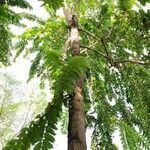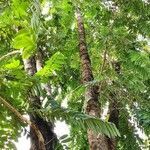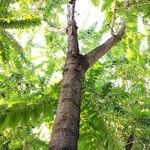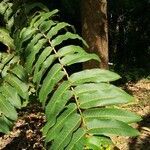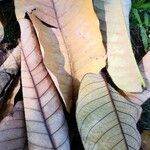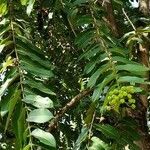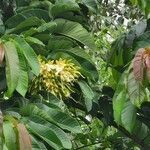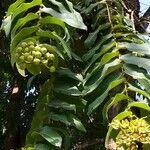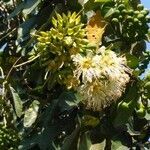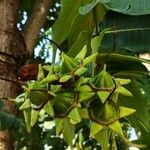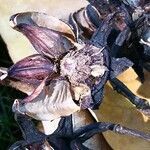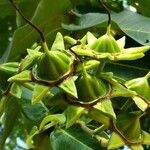Trees, medium to tall, 30[-40] m tall, glabrous. Leaves rigid, distichous; petiole to 1.2 cm; leaf blade abaxially pale green, adaxially dark green, ovate to oblong, broad, 12-15 × 5-7 cm, abaxially glaucous, lateral veins [12-]20-24 pairs, base cordate, apex shortly acuminate. Corymbs 3-20-flowered, drooping at ends of branches; pedicels 3-4 cm, stout. Floral tube broadly campanulate, 1.6-2.5 × 1.8-3 cm; sepals (5 or)6, green, thick, enlarged in fruit. Petals 6, white, obovate, 2.5-3 × 1.5-2 cm. Stamens numerous, ca. 50 or more, white, surpassing petals. Capsules subglobose, 3-4 × [3-]4-4.5 cm, 6-9-valved. Seeds 4-6 mm. Fl. spring. 2n = 48.
A tall evergreen tree. It grows to about 35 m high. It can be 60 m high. The trunk is smooth and greyish brown. It has hoop shaped ridges and leaf scars that are shaped like shields. The bark peels off in flakes. The leaves are 9-33 cm long by 4-11 cm wide. They are broadly sword shaped with a heart shaped base and a rounded tip. The flowers are white. They are held in large heads. The flowers come out at night. They have an unpleasant smell. The fruit is a capsule 3 cm across. It splits into 6 parts. There a 6 star shaped calyxes around the fruit. There are a large number of thread like seeds.
